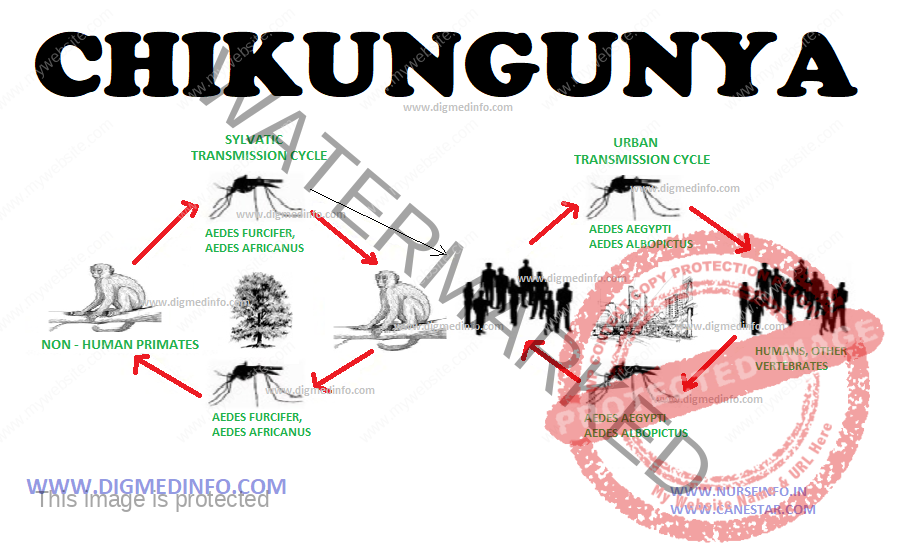CHIKUNGUNYA – Etiology, Distribution and Incidence, Transmission and Epidemiology, Clinical Features, Course and Prognosis, Diagnosis, Treatment, Prevention and Control
General Characteristics
Chikungunya (CHIK) fever is an acute infective disease, characterized by symmetric polyarthropathy, fever, rash, and rarely, generalized hemorrhages and CNS symptoms. The disease derives its name from the sudden onset of severe joint pain, which cripples the victim. The disease was first described in 1955 following an outbreak in Africa in 1952.
Etiology
CHIK virus is an alphavirus in the Semliki Forest complex (Togaviridae) and most closely related to o’nyong nyong(ONN) virus.
Distribution and Incidence
CHIK is widely distributed in Africa, the middle east, and Asia. The disease has now become endemic in several parts of India. In recent years as extensive epidemic affected several African and Asian countries, affecting millions of people. It is possible that the original virus has undergone genetic mutation.
Transmission and Epidemiology
In India, Aedes aegypti mosquito is the main vector. Aedes albopictus is also implicated. In Africa there is a sylvian cycle involving forest mosquitoes, humans and possibly other mammals. In Asia, sylvatic viral reservoirs have not been defined.
CLINICAL FEATURES
The incubation period varies from 2-10 days, usually 3-7days. The onset is sudden with abrupt fever (above 40oC), chills and rigor, headache, body pains and joint pains. There may be mild conjunctivitis, pharyngitis an erythematous rash over the body and face. The joints may be so inflamed that normal activities, standing and walking become painful. Arthropathy is symmetric, affecting the extremities and less often the shoulders and hips. Definite joint effusion is seen in 10% of cases. Small joints of the hands and feet and major joints of the lower limbs are affected most. Pain may be excruciating, crippling the patient quite out of propotion to the general disability. Fever and joint pains persist for up to six days after which they subside. Residual arthropathy lasting for months may occur in up to 30% of adults; especially in elderly patients. Morning stiffness and pain may persist for even a few months. Pre-exsisting joint problems and neurological disorders considerably worsen the disability and delay recovery. Joint pains are milder and may be even entirely absent in children.
A faint maculopapular rash may appear concurrently with defervescence. Complications such as hyperpyrexia, hemorrhagic manifestations, encephalitis, polyneuropathy of the Guillain-Barré type and ECG chages suggestive of myocarditis were recorded in the Madras outbreak. Hyperpyrexia caused death in one patient. Among asymptomatic subjects 38.4% showed hemagglutination (HI) antibodies to chickungunya virus, confirming the presence of the virus in the community.
Hemorrhagic manifestations occur occasionally. CNS manifestations like meningism, convulsions and acute polyneuropathy has been reported in a minority of patients, especially children and infants.
Course and Prognosis
The diseases many run a benign course with slow recovery even if untreated. Arthropathy may persist for varying periods and can be disabling. The acute illness in children and infants and elderly persons can be fatal. The primary role of uncomplicated chickungunya as a cause of death is not established. It produces considerable morbidity and impairment of the quality of life for prolonged periods.
Diagnosis
Routine laboratory investigations are not specific. The ESR may be elevated to 20-50 mm/hr and CRP may also be elevated. Isolating the virus or identifying genomic products by PCR in acute phase blood specimens can confirm the diagnosis. Serologically specific IgM or other antibodies can be demonstrated by IgM capture ELISA test. This test will distinguish the condition form dengue which is also transmitted by the same vector.
Treatment
Rest and symptomatic treatment with non-steroidal anti-inflammatory drugs give relief. Prolonged arthropathy demands symptomatic treatment. Chloroquine given in a dose of 250 mg od or bd has been reported to be useful. In any case results are not impressive.
Prevention and Control
An experimental live attenuated vaccine has been shown to produce high levels of neutralizing antibody in human volunteers but efficacy has not been tested. Anti-mosquito measures and personal protection with mosquito repellants will reduce the spread.


